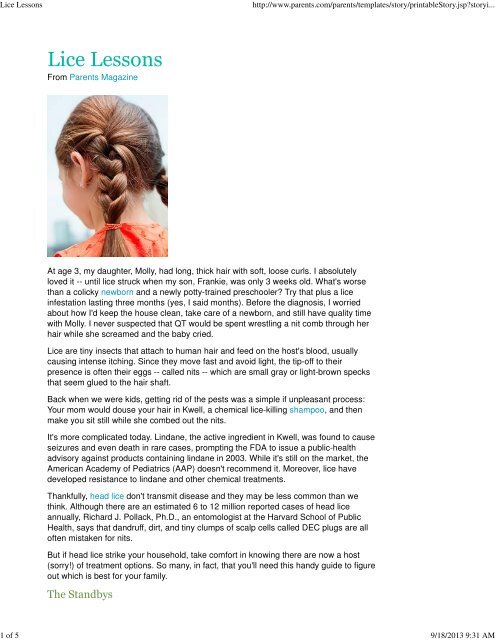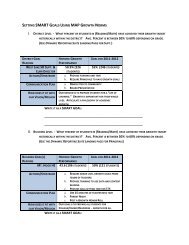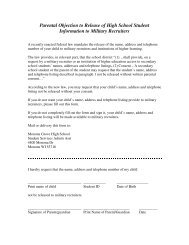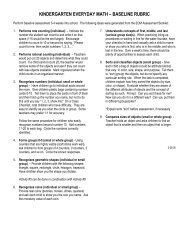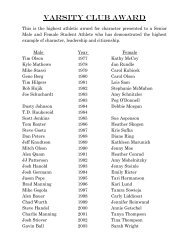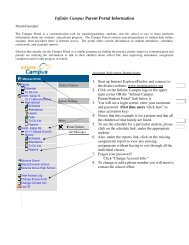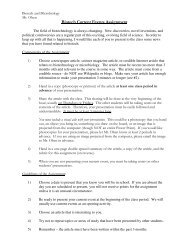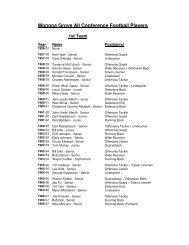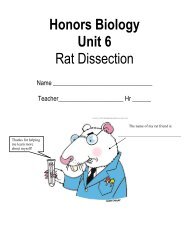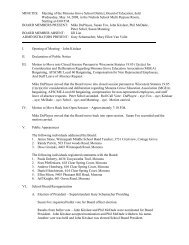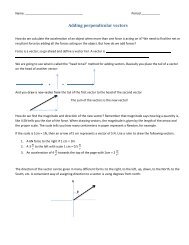Lice Lessons
Lice Lessons from Parent Magazine - Monona Grove Schools
Lice Lessons from Parent Magazine - Monona Grove Schools
You also want an ePaper? Increase the reach of your titles
YUMPU automatically turns print PDFs into web optimized ePapers that Google loves.
<strong>Lice</strong> <strong>Lessons</strong><br />
http://www.parents.com/parents/templates/story/printableStory.jsp?storyi...<br />
1 of 5 9/18/2013 9:31 AM<br />
<strong>Lice</strong> <strong>Lessons</strong><br />
From Parents Magazine<br />
At age 3, my daughter, Molly, had long, thick hair with soft, loose curls. I absolutely<br />
loved it -- until lice struck when my son, Frankie, was only 3 weeks old. What's worse<br />
than a colicky newborn and a newly potty-trained preschooler? Try that plus a lice<br />
infestation lasting three months (yes, I said months). Before the diagnosis, I worried<br />
about how I'd keep the house clean, take care of a newborn, and still have quality time<br />
with Molly. I never suspected that QT would be spent wrestling a nit comb through her<br />
hair while she screamed and the baby cried.<br />
<strong>Lice</strong> are tiny insects that attach to human hair and feed on the host's blood, usually<br />
causing intense itching. Since they move fast and avoid light, the tip-off to their<br />
presence is often their eggs -- called nits -- which are small gray or light-brown specks<br />
that seem glued to the hair shaft.<br />
Back when we were kids, getting rid of the pests was a simple if unpleasant process:<br />
Your mom would douse your hair in Kwell, a chemical lice-killing shampoo, and then<br />
make you sit still while she combed out the nits.<br />
It's more complicated today. Lindane, the active ingredient in Kwell, was found to cause<br />
seizures and even death in rare cases, prompting the FDA to issue a public-health<br />
advisory against products containing lindane in 2003. While it's still on the market, the<br />
American Academy of Pediatrics (AAP) doesn't recommend it. Moreover, lice have<br />
developed resistance to lindane and other chemical treatments.<br />
Thankfully, head lice don't transmit disease and they may be less common than we<br />
think. Although there are an estimated 6 to 12 million reported cases of head lice<br />
annually, Richard J. Pollack, Ph.D., an entomologist at the Harvard School of Public<br />
Health, says that dandruff, dirt, and tiny clumps of scalp cells called DEC plugs are all<br />
often mistaken for nits.<br />
But if head lice strike your household, take comfort in knowing there are now a host<br />
(sorry!) of treatment options. So many, in fact, that you'll need this handy guide to figure<br />
out which is best for your family.<br />
The Standbys
<strong>Lice</strong> <strong>Lessons</strong><br />
http://www.parents.com/parents/templates/story/printableStory.jsp?storyi...<br />
2 of 5 9/18/2013 9:31 AM<br />
Are you most comfortable with a removal method that's been around a while? Choose<br />
one of these.<br />
Louse- and nit-combing<br />
This is the oldest approach. If you use it with another treatment, follow package<br />
directions for that product. If it's your sole method, slow down lice before you comb by<br />
moistening hair with any thick white conditioner (which makes it easier to get the comb<br />
through), or a dimethicone-based product such as <strong>Lice</strong>MD PesticideFree, or a mix of<br />
conditioner and baking soda (for extra grip). This way you can remove live lice and nits.<br />
For two weeks, comb the entire head every day or so, targeting a small section at a<br />
time and starting as close to the scalp as possible. Most experts recommend using a<br />
metal nit comb (found at drugstores) and wiping off the nits and lice frequently. The<br />
process can take more than an hour and works only if you get every louse and viable<br />
egg. (Put on a movie for your kid!)<br />
Over-the-counter chemical treatments<br />
These include the brands Nix (for kids 2 months and up) and Rid (2 years and up).<br />
They get their power from the chrysanthemum flower, either through its extracts<br />
(pyrethrin) or a synthetic version (permethrin). Treatments that have these ingredients<br />
are the only OTC products that are FDA-approved to treat head lice. They come in a<br />
rinse or a shampoo you leave on the hair for ten minutes, but they can't completely kill<br />
the eggs, so you'll need to nit-comb and re-treat nine days later to kill any newly<br />
hatched lice. These products have been used for years, but lice are becoming<br />
increasingly resistant to them. However, the AAP still recommends this type of<br />
treatment as the first line of defense. "It has the longest safety track record, it's<br />
available without a prescription at a fair price, and it will work in the majority of cases if<br />
used correctly," says Barbara Frankowski, M.D., professor of pediatrics at The<br />
University of Vermont College of Medicine and coauthor of the AAP's most recent<br />
report on head lice.<br />
Malathion<br />
This lotion (brand name: Ovide, for ages 6 and up) is an insecticide commonly used to<br />
fight agricultural pests. It's about 90 percent effective, but is also flammable and needs<br />
to be left on a child's head for eight to 12 hours. It's supposed to kill lice and eggs in<br />
one treatment, though you can re-treat in seven to nine days if needed. It's available<br />
only by prescription and is the only Rx treatment that comes in generic form (which<br />
costs less).<br />
Your kid's doc may want you to try an OTC chemical treatment first. If you do but you<br />
still find live lice in the next day or two, she may recommend one of these new Rx<br />
options, all of which are lotions you leave on the hair for ten minutes.<br />
Ulesfia (benzyl alcohol)
<strong>Lice</strong> <strong>Lessons</strong><br />
http://www.parents.com/parents/templates/story/printableStory.jsp?storyi...<br />
3 of 5 9/18/2013 9:31 AM<br />
Approved for kids 6 months and up, this works by asphyxiating lice; it's not a chemical<br />
pesticide. It doesn't kill the eggs, so you need two rounds of the lotion and combing is<br />
recommended, but one study reported a 100 percent "cure" rate.<br />
Natroba (spinosad)<br />
Derived from the fermentation of a soil bacterium, Natroba (for ages 4 and up)<br />
paralyzes the lice, but is safe because it can't get into the human nervous system. Its<br />
cure rate is about 85 percent. Unlike Ulesfia, Natroba kills the eggs, which means your<br />
child probably needs only one treatment. It should also mean no nit-combing, but this<br />
med (and others that don't require nit-picking) only kills the eggs; it doesn't make them<br />
disappear. So if you don't want your kid to have a head full of dead lice eggs or her<br />
school has a no-nit policy, you have to comb them out.<br />
Sklice (Ivermectin)<br />
This also works by paralysis and should need only one application, but its cure rate is<br />
about 75 percent. It's for ages 6 months and up.<br />
New Nondrug Options<br />
Some parents choose to skip calling the doctor and try one of these.<br />
AirAllé<br />
This device, which was formerly called LouseBuster and is cleared by the FDA, uses<br />
controlled, heated air to kill lice and eggs in a single treatment. Research results have<br />
been impressive: In one study, 95 percent of lice and eggs were killed. A drawback is<br />
availability, because the device can be used only by a certified operator (find one at<br />
laradasciences.com). Another consideration is cost: Expect to pay between $150 and<br />
$250, depending on where you live, though the fee is commonly reimbursed through<br />
flexible-spending accounts.<br />
<strong>Lice</strong>-removal services and salons<br />
These businesses do the nit-picking for you, usually for a hefty price. Staffers also may<br />
use (and sell) their own shampoo and other products. Going this route may work -- or<br />
not. The companies aren't regulated, so there's no set standard for training, knowledge,<br />
or success.<br />
Can essential oils prevent lice?<br />
It's a question many parents ask, feeling that sending their child to a lice-prone<br />
classroom is akin to marching her into battle without armor. Studies have shown that<br />
some essential oils do, indeed, possess anti-lice properties. But, like other natural<br />
products, lice treatments based on these scented oils aren't required to be tested and<br />
FDA-approved. Heather Jeney, M.D., an integrative pediatrician in Montclair, New<br />
Jersey, has found certain formulas -- including Fairy Tales' Rosemary Repel line -- to<br />
be effective, while Stuart Ditchek, M.D., a pediatrician in Brooklyn, New York, and an<br />
author of Healthy Child, Whole Child, stands behind <strong>Lice</strong>nders' peppermint<br />
oil-containing products. Both companies' products are designed to be applied regularly<br />
to repel lice and to eliminate an active infestation, when used in combination with<br />
proper nit and lice removal.<br />
A word of caution: Never use an undiluted essential oil on your child without consulting<br />
her doctor -- it can be irritating and potentially toxic.<br />
Home Remedies<br />
You can see the appeal: These common substances are cheap, readily available, and<br />
nontoxic. Some people swear by them. Others say that controlled studies are lacking<br />
and you're better off with a proven method.
<strong>Lice</strong> <strong>Lessons</strong><br />
http://www.parents.com/parents/templates/story/printableStory.jsp?storyi...<br />
4 of 5 9/18/2013 9:31 AM<br />
Olive oil, butter, petroleum jelly, Crisco, mayonnaise<br />
There are many methods for using these, but they generally involve, in various orders,<br />
nit-combing, dousing the hair and scalp with the substance, leaving it on overnight<br />
under a shower cap to suffocate lice, and repeating the process at least twice. These<br />
greasy substances can be difficult to remove, so serious shampooing afterward is<br />
necessary.<br />
Cetaphil<br />
Dermatologist Dale Pearlman, M.D., of Menlo Park, California, published a study in<br />
Pediatrics about a lotion found to be 96 percent effective in curing head lice. He later<br />
explained that the lotion was the gentle facial cleanser Cetaphil. While some have<br />
criticized his study and Cetaphil hasn't been evaluated by the FDA for head lice, Dr.<br />
Frankowski has found that it works in most cases "if the family follows all the directions<br />
properly."<br />
• Get instructions for Dr. Pearlman's Nuvo Method for Treating Head <strong>Lice</strong>. >><br />
DO rinse chemical treatments in the sink (rather than the tub) to minimize skin<br />
exposure; nit-comb over a disposable drop cloth.<br />
DO pay special attention to the nape of your child's neck and behind the ears -- a<br />
louse's favorite places to hang out.<br />
DON'T think continued itching means that a treatment has failed. A kid can keep itching<br />
for days after lice are gone.<br />
DON'T wash your child's hair obsessively during an outbreak. Head lice aren't a sign of<br />
poor hygiene.<br />
DON'T use any household insecticides, such as those for roaches or ants. They are<br />
not intended for human use and shouldn't be applied to hair or skin.<br />
Epilogue<br />
Why did it take my family three months to be lice-free? Not because of anything<br />
complex like pesticide resistance, but rather good old reinfestation. Turned out I had<br />
the critters too. While I was dogged about checking Molly's hair -- I got lax about<br />
checking my own after I didn't find anything the first few times. (Plus, it's really hard to<br />
check your own hair well.) Once we got on the same treatment schedule, the lice<br />
disappeared and our house returned to normal -- or as normal as a house can be with<br />
a colicky baby and a newly potty-trained preschooler.<br />
Originally published in the September 2013 issue of Parents magazine.<br />
All content on this Web site, including medical opinion and any other health-related
<strong>Lice</strong> <strong>Lessons</strong><br />
http://www.parents.com/parents/templates/story/printableStory.jsp?storyi...<br />
5 of 5 9/18/2013 9:31 AM<br />
information, is for informational purposes only and should not be considered to be a<br />
specific diagnosis or treatment plan for any individual situation. Use of this site and the<br />
information contained herein does not create a doctor-patient relationship. Always seek<br />
the direct advice of your own doctor in connection with any questions or issues you<br />
may have regarding your own health or the health of others.<br />
Parents.com<br />
© Copyright 2013, Meredith Corporation. All Rights Reserved.


